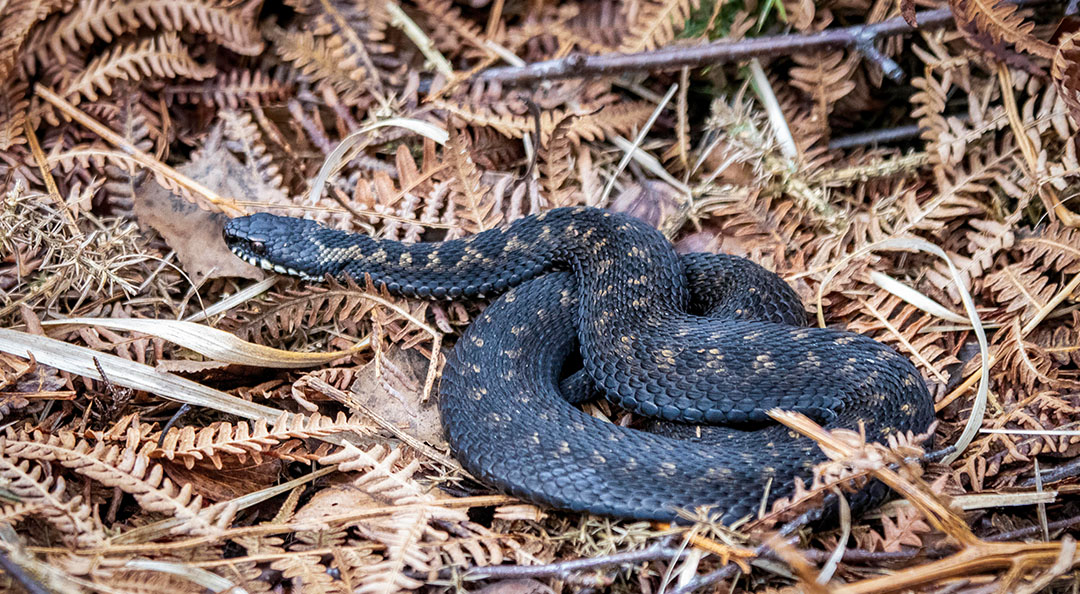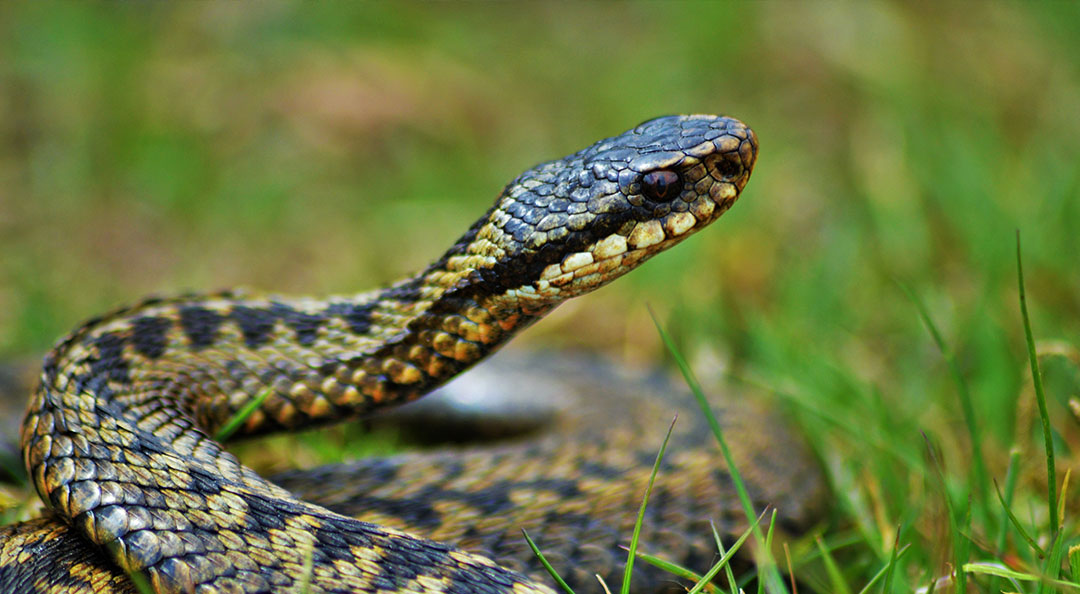
Close-up of an Adder (Vipera berus) amongst bracken, showing its distinctive zig-zag pattern
The Isle of Mull, and indeed much of the UK’s wild countryside, is home to a diverse array of wildlife, including the adder (Vipera berus). These fascinating reptiles hold a unique place as Britain’s only native venomous snake. While encounters are rare and adder bites even rarer, especially if you know how to behave, understanding these shy creatures is crucial for your safety and theirs. This guide will provide you with essential information on identifying adders, avoiding encounters, and knowing exactly what to do in the unlikely event of a bite, ensuring you can enjoy Mull’s natural beauty responsibly and with peace of mind.
1. Adder Identification & Habitat
Knowing what an adder looks like and where it typically lives will help you appreciate them from a safe distance.
- What Do Adders Look Like?
- Size: Adders are relatively small snakes, typically growing up to 60-70 cm (24-28 inches) in length, though some may be larger.
- Distinctive Markings:
- Zig-zag Pattern: The most identifying feature is a dark, distinct zig-zag stripe running along the entire length of their back.
- Head Markings: They have a dark ‘V’ or ‘X’ shaped marking on the back of their relatively flat head.
- Eyes: Adders have vertical, slit-like pupils, unlike the round pupils of non-venomous grass snakes.
- Colour Variations:
- Males are typically grey with dark black markings.
- Females are usually light brown or reddish-brown with darker brown markings.
- Occasionally, entirely black (melanistic) adders can be found, making the zig-zag pattern hard to see.
- Distinguishing from Other Reptiles:
- Grass Snake: Larger, greener/greyer, with a distinctive yellow and black collar behind the head, and round pupils.
- Smooth Snake: Much rarer, usually smaller, slenderer, with a less distinct pattern and round pupils.
- Slow Worm: A legless lizard, not a snake. Smooth, shiny, no zig-zag pattern, and has eyelids.
- Where Are They Found?
- Preferred Habitats: Adders favour open habitats where they can bask in the sun, interspersed with cover. These include:
- Heathland and moorland (common on Mull)
- Woodland edges and clearings
- Grassy banks and rough grassland
- Coastal dunes.
- Basking Spots: They are often seen basking on rocks, logs, or warm patches of ground to regulate their body temperature.
- Preferred Habitats: Adders favour open habitats where they can bask in the sun, interspersed with cover. These include:
- When Are They Most Active?
- Adders emerge from hibernation in early spring (March/April) and are most active during the warmer months, especially from **April to September**. They are generally diurnal (active during the day).

Keep dogs on a lead in adder habitats.
2. Avoiding Encounters & Respecting Their Space
Adders are shy and non-aggressive creatures that will typically try to avoid humans. Bites almost always occur when an adder is startled, feels threatened, or is accidentally stood on.
- Stay on Marked Paths:
- When walking in areas known for adders, stick to clear paths and avoid venturing into dense vegetation, long grass, or bracken where an adder might be resting unseen.
- Wear Sturdy Footwear:
- Walking boots or sturdy shoes offer protection should you accidentally step near an adder.
- Avoid walking barefoot or in open sandals in adder habitats.
- Keep Dogs on a Lead:
- Dogs are particularly vulnerable to adder bites, often getting bitten on the face or paws after disturbing an adder out of curiosity.
- In known adder areas, keep your dog on a short lead to prevent them from exploring dense undergrowth.
- Make Some Noise:
- Adders are sensitive to vibrations. Walking with purpose or making a little noise can often encourage them to move away before you get too close.
- Do Not Provoke or Approach:
- If you see an adder, keep your distance. Do not try to touch it, pick it up, or provoke it in any way.
- Adders are a protected species under the Wildlife and Countryside Act 1981, making it illegal to intentionally kill, injure, or sell them.
3. If You See an Adder
Consider yourself lucky! Seeing an adder in the wild is a rare and special experience.
- Remain Calm:
- Panicking can startle the snake further.
- Give it Space:
- Adders will almost always choose to escape rather than confront. Slowly back away and allow it to move off undisturbed.
- Keep children and dogs away from the area.
- Enjoy the Sighting:
- If it’s safe to do so and you maintain a good distance, take a moment to appreciate this beautiful and elusive creature.

Close up of an adder in the grass.
4. What to Do if Bitten (for Humans)
Adder bites are rare and rarely fatal, but they do require immediate medical attention.
- Immediate Actions:
- Stay Calm: This is crucial. Panic can increase your heart rate and potentially spread venom more quickly.
- Immobilise the Limb: Keep the bitten limb as still as possible. Avoid walking or exercising unnecessarily. If on an arm or leg, consider trying to keep it below heart level.
- Remove Jewellery/Tight Clothing: Remove any rings, watches, or tight clothing near the bite, as swelling is likely to occur.
- Call for Emergency Help: **Dial 999 (or 111 for non-life-threatening advice)** immediately and state that you or the person has a suspected adder bite. They will advise on the next steps and potentially arrange transport to a hospital.
- What NOT to Do:
- Do NOT try to suck out the venom.
- Do NOT cut the wound.
- Do NOT apply a tourniquet.
- Do NOT apply ice or heat to the bite.
- Do NOT walk or run, if possible.
- Do NOT try to catch or kill the snake.
5. What to Do if Your Dog is Bitten
Dogs are unfortunately more likely to be bitten than humans due to their natural curiosity and tendency to explore undergrowth. Prompt veterinary attention is essential.
- Immediate Actions:
- Stay Calm: For both your sake and your dog’s.
- Carry Your Dog: If possible, carry your dog to minimise movement, which can help slow the spread of venom. Do not let them walk.
- Keep Still & Calm: Try to keep your dog as quiet and still as possible.
- Clean the Wound (Gently): You can gently clean the bite wound with water if it’s visible, but do not rub or try to extract venom.
- Contact Your Vet Immediately: Call your vet straight away and tell them you suspect an adder bite. They will advise you on the quickest route to the clinic and prepare for your arrival.
- Common Symptoms in Dogs:
- Sudden yelp or pain.
- Rapid, often significant, swelling near the bite (most common on face, head, or limbs).
- Lameness or reluctance to move.
- Lethargy, weakness, shaking.
- Drooling, vomiting, or diarrhoea.
- In severe cases, collapse or difficulty breathing.
Adders are a valuable and fascinating part of the UK’s natural heritage. By understanding their behaviour and knowing how to react in the unlikely event of an encounter or bite, you can continue to enjoy the wild beauty of places like the Isle of Mull safely and respectfully. Awareness is your best defence!
